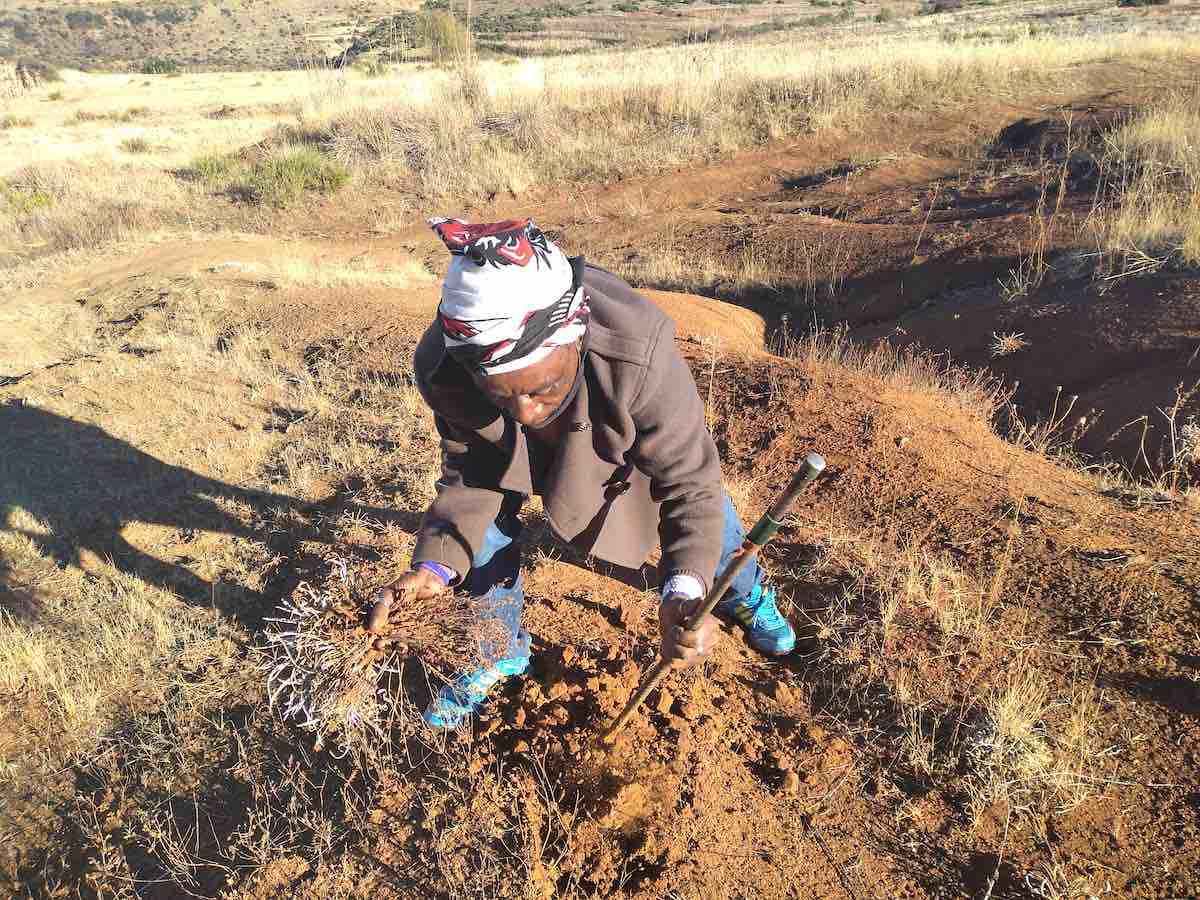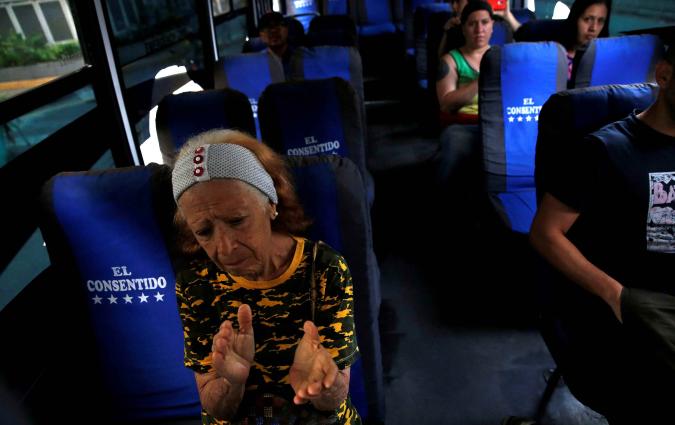These projects are putting Indigenous voices at the heart of their journalism

Traditional healer Mohaneng Lekhooana harvests traditional medicine in his home town of Ha Mantsa in Maseru, Lesotho. | Credit: EJN / Pascalinah Kabi
There are an estimated 476 million Indigenous people globally, living across 90 countries and speaking the majority of the world’s languages. They account for approximately 6% of the world’s population and safeguard 80% of the biodiversity left on the planet, according to World Bank data. They are on the frontlines of fights against deforestation, land misuse, government corruption and climate change.
Indigenous peoples have often been misrepresented or underrepresented by the news media. According to the 2020 Global Media Monitor Project’s report Who Makes the News?, only 3% of people featured in the news in Latin America were from Indigenous or tribal groups. “The failure to represent the diversity of people and opinion present in society not only has implications for public discourse and decision-making, but it also plays a role in eroding trust in news journalism,” the report says. In April the Reuters Institute’s Trust in News Project published a report with similar findings.
Several projects around the world are trying to address these failures either by working with Indigenous peoples or by creating Indigenous-led media companies. Their goal is drawing greater attention to Indigenous knowledge, narratives and cultures. They all face similar challenges, from lack of funding to engaging with audiences who are often offline and difficult to reach. I spoke to journalists from Colombia, Kenya, India and Indonesia to learn more about these projects, and what they are trying to achieve.
Better reporting on Indigenous issues
Colombia-based, independent news outlet Agenda Propia has devised its own methodology for reporting on Indigenous issues and with Indigenous journalists and sources. The project works across Central and South America, a region where more than 800 Indigenous cultures are present if we include the Caribbean.
Agenda Propia’s Intercultural Collaborative Journalism methodology, also called “co-creation,” has eight steps, from the conception of a story through development and production. The steps include holding “word circles” with Indigenous experts or advisers, a traditional practice allowing for ideas to be shared; and “walking the territory” to better understand the places and spaces from the Indigenous community’s perspective.
The result is storytelling and journalism that puts the focus on Indigenous people, on “how they organise and [on] the structures they use so you can convey what is happening in these communities,” says Edilma Prada Céspedes, journalist and editor of Agenda Propia.
“We want to decolonise the news and put Indigenous people at the centre of the process. We want to bring them out of the margins and make sure they are the official voice of their communities. This isn’t something that usually happens in newsrooms,” says Prada, speaking via an interpreter.
Reports created with this methodology include the Drawing My Reality series, which shares the stories of children from 12 Indigenous communities across Mexico, Guatemala, Honduras, Colombia, Venezuela, Ecuador, Bolivia, Peru and Chile. Each child or adolescent created a drawing of their “reality” as an Indigenous person in Latin America, which is published alongside reporting on the issues it raises, from the story of a family in Guatemala whose father died trying to reach the US to the views of students at an Indigenous school on Chile’s new constitution.
Aiming for better representation
To improve the representation and coverage of Indigenous communities, Agenda Propia has editorial board meetings involving journalists and Indigenous leaders and citizens. At these meetings, reporting topics are discussed in advance. “We don't want to prejudge what we should cover, but try to learn from the kinds of issues that they are interested in,” says Prada. Stories on deforestation, criminal groups, drug trafficking and human rights have all originated from these meetings.
Agenda Propia has helped build a 350-strong network of Indigenous and non-Indigenous journalists across Latin America to foster collaboration on covering Indigenous issues. “It cuts both ways,” says Prada. “Indigenous journalists teach non-Indigenous journalists about their communities, how important the concept of land is and nuances that are important to take into account during coverage. Non-Indigenous journalists give insights into journalism techniques and formats.” Newsrooms could replicate this network through advisory boards, where Indigenous people could advise on stories, sources and issues, and assist with the editing process.
Such collaboration can also inform reporting formats through a greater understanding of traditional narratives or cultures. For example, suppose a community has a more oral or visual culture, reporters could reflect this issue in their own reporting, says Prada, who stresses that newsrooms can learn from the radio and film documentaries produced by Indigenous communities in the region.
Recruiting Indigenous voices to any kind of advisory board can be challenging, acknowledges Prada, but Indigenous universities in countries like Colombia and Nicaragua have students and graduates who can help. For newsrooms to acknowledge the existence of Indigenous journalists and reach out is an important first step, she adds. News organisations need to make an effort to get Indigenous journalists into the industry and support the development of more Indigenous editors, says Prada: “They have a lot to offer journalism. This doesn’t happen very often in Latin America.”.
How to reach an Indigenous audience
Reaching Indigenous audiences is often difficult for mainstream news organisations. Communities may be well served by their own outlets and may lack the equipment or connectivity to access digital journalism.
Independent newsroom Raíchali Noticias is committed to covering the Indigenous populations of the Mexican state of Chihuahua. This has involved a radical rethinking of its content, its news products and its distribution strategy. To share information about the COVID-19 pandemic in 2020, for example, Raíchali Noticias launched a bilingual podcast to reach Spanish-speaking audiences and the Rarámuri people, a large Indigenous population in Chihuahua.
Public-interest, investigative outlet Project Multatuli in Indonesia has no paywall on its website so the under-reported communities it covers can easily access the handful of slow journalism stories it produces in a year, says co-founder Evi Mariani. “A lot of Indigenous people in Indonesia don’t read the news though. They come from an oral tradition, and prefer that to reading or writing.”
Another format, such as podcasting, would suit this tradition but podcast audiences in Indonesia are typically richer and more formally educated, as they have access to more mobile data, suggests Mariani. A 2021 survey of media consumption habits in Indonesia suggests two-thirds of media consumers don’t listen to podcasts. The Project Multatuli team shares links to stories directly with Indigenous communities, but this doesn’t guarantee that those who have access will read them. They share the stories through a local alliance of Indigenous peoples too, but they also want their journalism to reach an audience of policymakers and leaders whose decisions affect Indigenous communities.
“We serve the underreported not necessarily by having the underreported themselves as an audience, but because a lot of underreported communities in Indonesia need their voices to be heard. They need their cause to be broadcast. They need solidarity from the public,” says Mariani. “It’s about centring [Indigenous people’s] stories, de-marginalising them, so urban people and formally educated people and decision-makers can read them.”
The challenges for Indigenous journalists
Alexander Kisioi is a freelance journalist and a member of the Indigenous Ogiek people in Kenya. The Ogiek have inhabited the Mau forest for centuries. According to the charity Minority Rights, they are some of Africa’s only remaining forest dwellers. The Ogiek’s livelihoods and homes are under threat from agricultural expansion and extractive industries such as logging and charcoal. They continue to face eviction from parts of the forest despite a legal ruling in 2017 that the Kenyan government had violated their rights to ancestral land through evictions.
“It’s like fish and water. When you remove the fish from the water, it will die; when we remove Ogiek from the forest, we will not feel comfortable,” says Kisioi. For him, conserving the forest can also help preserve the Ogiek’s culture, from its language to its practices. The corporations and communities extracting from the forest come from different counties and places. “There’s a challenge when these communities come to our county and interfere with our culture.”
Kisioi uses a mobile phone to take pictures and record audio and interviews from the forest. It is a way of documenting the destruction of this important ecosystem. Members of his community who are scouts and patrol the land share their pictures with him too. His recent reports include updates on Kenyan Forestry Service operations to crack down on the illegal transportation of firewood from the forest by donkey and allegations of illegal logging.
Kisioi says he is the first journalist from his community. Helping the Ogiek raise these issues in the media, he says, and gives his people a voice that’s often not present within government.
As an Indigenous journalist, Kisioi has the knowledge and relationships to tell the story of the Ogiek and the environment in which they live. But he has no equipment other than his phone, and he shares his reports on social media and with local newsrooms, not all of which offer a fee.
A dangerous role
Kisioi is a self-declared activist as well as a journalist – a role that has become increasingly dangerous in recent decades. More than 1,700 environment and land defenders were killed between 2012 and 2021 and a reported estimate of 30 environmental journalists have been killed in the past 10 years. He says people have tried to discredit his images, claiming they are old photos, but he has not yet been threatened for his work: “[The authorities and the extractive industries] fear me because I’m a journalist, but I don’t have any security.”
Many Indigenous journalists live in places “on the other side of the digital divide and lose out on certain opportunities”, says Stella Paul, project officer for environment and health for Internews’ Earth Journalism Network (EJN). “We have a moral responsibility to find the people who have the passion and ability, and give them additional support to tell their stories.”
The logistics and the cost of reporting on Indigenous issues can be a significant challenge for media not based within the community or local to it. Multatuli’s Mariani recalls reporting on a school set up by Indigenous youth in South Sulawesi to further education and revive customs. Organising the visit took months as the reporter first needed an invitation from the King. They then had to travel three hours by car from the provincial capital to the nearest town. The rainy season had left the road ahead muddy and impassable even to motorbikes, so they walked another hour to reach the village. An interpreter was needed to communicate with villagers who don’t speak Indonesian, which can also mean details are lost in translation.
A recent reporting trip to Papua to document the impact of the trans-Papua highway project (the construction of more than 4,300 kilometres of road across Papua and West Papua that could cause the reported loss of 4.5 million hectares of forest) cost around 100 million Rupiah (around $6,700), even working with a local media partner. This covered logistics and pay for two journalists travelling a 1,200 kilometres round trip to report on one leg of the highway project. “And yet if we don’t send anyone we won’t have documentation of what’s happening with a project which will divide villages and forests,” Mariani says.
Training Indigenous Journalists
Training specifically aimed at Indigenous journalists can help mitigate some of these challenges. The Earth Journalism Network runs training and a story development programme as part of its Green Recovery Project and facilitates story grants through its Indigenous Environmental Journalism project. Many participants don’t have direct or good access to facilities, equipment, grants or mentors for their journalism.
“In most cases, Indigenous journalists don’t have the access, skills or opportunities to tell the story that matters to them,” says Paul, who is an Indigenous journalist herself. “Then the perspective [of the Indigenous community] goes missing.”
On the other hand, non-Indigenous journalists seeking community voices to balance their stories may not have access or the right relationships, which can make the story weaker and even unpublishable. “Most of the problems Indigenous journalists face are strongly tied to rights violations,” she says. “Unless you have personally felt it and lived it, you miss some nuances.”
Indigenous journalists’ stories published with the support of EJN include Diana Taremwa Karakire’s report from north-eastern Uganda on the threat of the mining industry to the livelihoods and environment of the Karamojong people. From the Solomon Islands, Indigenous journalist Fredrick Kusu has reported on the damage from mining to the Chovohio River and Turarana community while Pascalinah Kabi has investigated the medicinal plants facing extinction in Lesotho.
Paul says much of the training offered to Indigenous journalists focuses on citizen journalism or links activism and journalism: “This can be tricky as Indigenous journalists often feel emotionally connected to their story. While we do want journalists to bring in their own experiences, we don’t want to lose objectivity. If you make a journalist into an activist, you may threaten their credibility.”
The challenge of the business model
Are newsrooms covering Indigenous issues and working with Indigenous communities sustainable? The common business model of wealthy individuals or businesses as backers can cause conflict. “In Indonesia, the very rich are often politically wired or closely related to the extractive economy, such as mining, palm plantations or tobacco,” says Multatuli’s Mariani, who stresses these are the very industries threatening underreported communities.
The market-driven model can drive the cost of journalism down, which means no budget for marginalised people, Mariani says. This is why Project Multatuli opted for a grant-funded, public service model that’s “not common” in the country. “There are lots of underreported communities in Indonesia, including Indigenous communities,” says Mariani. “We are trying to disrupt the dominant practices of journalism. We are not concerning ourselves with only the issues of the elite.”
In every email we send you'll find original reporting, evidence-based insights, online seminars and readings curated from 100s of sources - all in 5 minutes.
- Twice a week
- More than 20,000 people receive it
- Unsubscribe any time






